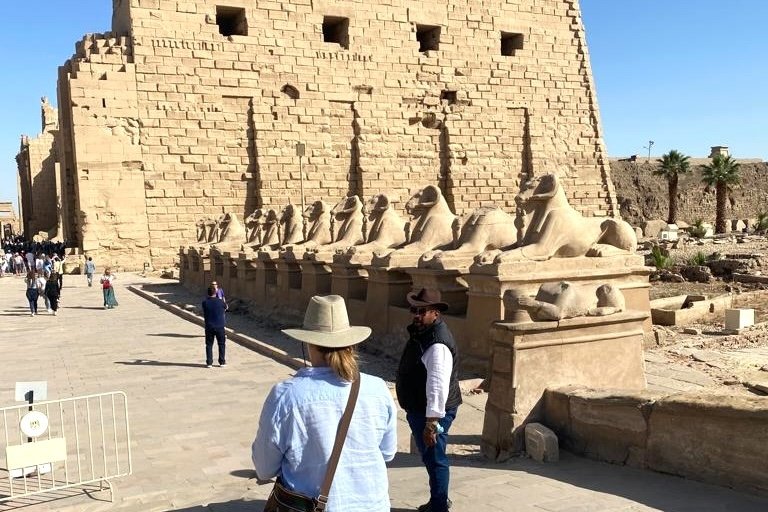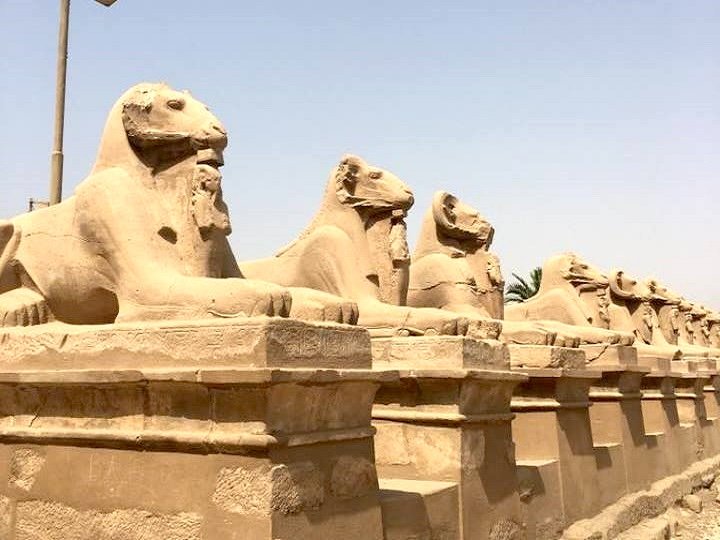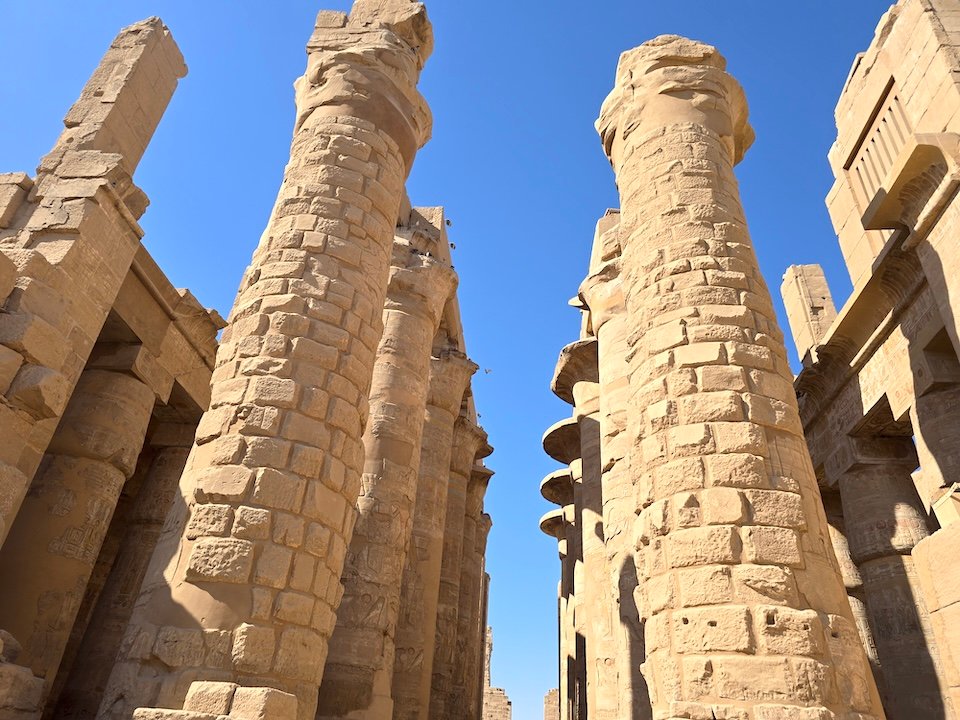The History and Location of Karnak Temple.
“Karnak Temple” that archaeological temple that is located on the eastern bank of the Nile River, and is considered one of the most important tourist attractions in Luxor, which was called in the ancient Pharaonic ages the name “Thebes“, or “the fortified city” that was known as “Abit Rast” in hieroglyphics language, that is, the most prestigious and dignity place.

The construction began in this complex with a small monastery that was established during the reign of King “Senusret I” in the middle kingdom in ancient Egypt; around the year 2000 BC, and until the Ptolemaic era lasted about 300 BC, that long period witnessed the rule of 30 pharaohs who contributed to its expansions, until its area reached 30 hectares, Each site within Karnak Temple is defined by the specific characteristics that reflect the ruling it experienced, resulting in a large collection of temples forming an integrated religious complex.
The Karnak Temple is the second largest old religious complex in the world after the “Angkor Wat” temple in Cambodia and the second most historical site in Egypt after the Pyramids of Giza, and it consists of four main parts: the courtyard of “Amun Ra, main god in Luxor” the boycott of “Mout wife of God Amun Ra,” the “Mentu the god of the war” province, and the King”Amenhotep IV” temple that was dismantled, in addition to a few small temples and sanctities that link Amon Ra and the Luxor Temple.
Every king added something new to these temples, reflecting the ancient Egyptians’ belief in a closeness to the gods, a desire for eternity, and the pursuit of immense fame among the people. The construction of the Karnak Temple spanned approximately two thousand years, and it features a unique engineering phenomenon: once a year, on December 21, the sun is perpendicular to the mihrab, also known as the “Jerusalem of Holies,” in the Karnak Temple, coinciding with the winter solstice.

The Design of Karnak Temple.
The “Sphinx Road” represents the main gate of the temple, featuring two rows of statues depicting a group of rams associated with Pharaoh Ramses II, known as the ancient “Wath Prose.” To lead the visitor to the first Paylon of Karnak temples, which is still not finished, due to being built at the end of the third century Bc.
Upon crossing through the gate, visitors will find the Courtyard of “Amun Ra, the god of creation, wind, and fertility,” was the site to show the sacred boat of the god for the visitor of the temple in ancient Egypt, which is a spacious area of about 250 thousand square meters; construction began during the 18th dynasty, when the significance of the unified ancient capital of Egypt became evident. The Temple of Ramses III is on the right, and the pharaoh Ramses II statue and a trusted pillar are on the left side of the courtyard.
The Biggest columns hall: Then, there is a hall of the columns, which began to be built during the era of the 18th dynasty, while most of the hall was completed during the era of the 19th family by the Kings “Seti I” and “Ramses II,” and the area of this hall is 5 thousand square meters, including 134 massive columns, coming in 16 consecutive rows, of which 122 columns reach a height of 10 meters, while there are 12 other columns up to 21 meters, as it reaches 21 meters, Each column is 3 meters in diameter, and near it are the obelisks of Thutmose I and Queen Hatshepsut, followed by a group of rooms and small courtyards. Only the pharaoh and the monks could enter this section of the temple.
On top of these columns are supports, each weighing approximately 70 tons. It is believed that they were raised to this height using cranes. However, because this process takes a long time and requires great balance to reach such great heights, an alternative theory has been proposed about how they were transported. It is that the Pharaohs created large slopes of sand, clay, and stone, and then dragged these giant stones up to the top of the slopes, placing them so that each piece rests on top of its designated column.
Karnak includes several temples, including the temple of Amun-Ra, the god of the sun, wind, and fertility. He was one of the main deities in the ancient Egyptian religion. His name means “the hidden god.” It is difficult to know exactly how his name was pronounced, as the ancient hieroglyphic language used consonants, so it was written “Amun” and pronounced “Amen.”
There is also the temple of the goddess Mut, the wife of the god Amun-Ra and the mother of the god Khons. Her name means “mother goddess,” and it was established by Queen Hatshepsut of the 18th Dynasty. Despite the Hyksos’ destruction of this temple, one of its obelisks still stands, considered the tallest ancient obelisk on earth. There is also the temple of Montu, the ancient Egyptian god of war. He was depicted as a man with a falcon’s head, wearing a crown of two feathers, between which was the sun disk. He usually appears at the bottom left of hieroglyphic inscriptions, as “M-N-T-W.”
The Sacred Lake:
In the heart of Karnak, there is the “Holy Lake,” which is still considered sacred. They believe in her sanctity, and they go to bless her; Even the women of Luxor have come to believe in its sanctity and visit it to seek its blessings.
The length of that lake is 80 meters, while its width reaches 40 meters. In the past, it was surrounded by a massive wall that was destroyed with the passage of time, and the kings and priests who served the ancient Egyptians were washing inside it before the beginning of any religious ceremonies or the national celebrations associated with the temples. There are on both sides of the northern and southern lake a measure of the Nile; their task is to determine the dates of the flood every year, and the lake still has two entrances, the first on the eastern side and the second on the western side.
The end of the use of Karnak Temple.
In 323 AD, the Roman Emperor Caius Flavius Valerius Aurelius Constantinus, known historically as Constantine I, recognized Christianity. Constantius II, his second son, commanded the destruction of all pagan temples across the empire in 326 AD. This period likely saw the abandonment of Karnak, particularly with the establishment of Christian churches amidst its ruins. The most notable example is the reuse of the festival hall in the central hall of Thutmose III, where painted decorations of saints and Coptic inscriptions can still be seen.

Engineering secrets and techniques used in building the Karnak temple.
The Karnak Temple is one of the greatest landmarks left by the Pharaonic civilization in ancient Egypt, as it is an ideal example of ancient architecture and elaborate architecture, and the temple has kept geometric secrets and amazing building techniques to this day.
Below is information about engineering secrets and technologies used in the construction of the temple:
Huge dimensions: The dimensions of the Karnak Temple are one of the largest dimensions that were used in building old temples, with a length of 134 meters and a width of 79 meters, while the height of one column in the main hallway reaches about 23 meters, and these dimensions are very amazing for the techniques available at that time.
Giant foundations: To endure this huge weight, the ancient Egyptians used giant foundations made of limestone, which weighs about 360 tons, and this is considered one of the largest foundations used in any building in the ancient world.
Sand Pillars: It was used in the construction of the Karnak Temple, a sandy pillar architectural technology to secure columns, symptoms, and separate panels, which were installed with sand and stone tools, and this technique is characterized by its allows to stretch and shrink with changing temperatures, which helps to avoid stone cracks.
Tour inside the Karnak Temples with facts.
1- Explore corridors and shrines: travelers to Luxor can explore many corridors with sacred shrines inside the temple, which hold many old secrets and symbols.
2. Access to closed rooms: Inside the temple, visitors can enter the closed rooms where ancient religious rites that were forbidden to the people of ancient Egypt are performed.
3. Lighting experience: You can take in a new perspective of the temple’s inscriptions and graphics by experiencing the lighting within the building.
4. Hear myths: Visitors can listen to the old myths and tales that describe the temple, its background, and its building.
5. Enjoying the historic atmosphere: While learning about ancient Egyptian culture and the historic building methods used there, visitors can take in the temple’s historic atmosphere.
6- Study the inscriptions and drawings: Visitors can study the inscriptions and drawings inside the temple, which give an idea of daily life and ancient myths that were very important in the civilization of the ancient Egyptians.
Trusted Partners
Nile Cruisen: Chosen by Leading Brands as Egypt's Top Cruise Operator











